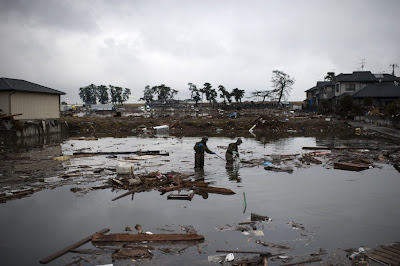 |
| Vehicle headlamps illuminate the disaster area of Yamada town in Iwate prefecture on March 16. The official toll of the dead and missing following a devastating earthquake and tsunami that flattened Japan's northeast coast has topped 11,000, with 3,676 confirmed dead. (STR/AFP/Getty Images) |
 |
| Yukie Ito (left), tries to comfort her daughter Hana, 8, with grandmother Tamiyo at a cold refugee center for the homeless March 16 in Kesennuma, Miyagi province. (Paula Bronstein/Getty Images) |
 |
| Rishiko reacts after visiting her home in the rubble of a village destroyed by the devastating earthquake and tsunami March 16 in Kesennuma, Miyagi province. (Paula Bronstein/Getty Images) |
 |
| Elderly people drink hot tea at a shelter at Yamada town in Iwate prefecture on March 16. (STR/AFP/Getty Images) |
 |
| Japanese Defense Force members load tsunami relief goods at the port in Kamaishi city, Iwate prefecture on March 16. (Toshifumi Kitamura/AFP/Getty Images) |
 |
| Damage caused by the March 11 earthquake and tsunami is seen from a hill overlooking the city of Kesennuma on March 16. (Philippe Lopez/AFP/Getty Images) |
 |
| Japanese Self Defence Force soldiers search for people missing from the March 11 earthquake and tsunami in a river bed in Miyako in Iwate prefecture on March 16. (Takashi Noguchi/AFP/Getty Images) |
 |
| A doll lies on the ground after the March 11 tsunami and earthquake in Natori in Miyagi Prefecture on March 16. (Toru Yamanaka/AFP/Getty Images) |
 |
| A man checks a list of evacuated people at a shelter in Rikuzentakada, in Iwate prefecture, on March 16. (STR/AFP/Getty Images) |
 |
| People stay close to the heater at a shelter at Yamada town in Iwate prefecture on March 16. (STR/AFP/Getty Images) |
 |
| Chieko Chiba walks through the rubble after going to see her destroyed home March 16, 2011 in Kesennuma, Miyagi province. (Paula Bronstein/Getty Images) |
 |
A car lies among debris swept inland by the tsunami following the earthquake in Minami Sanriku, Miyagi prefecture. (Robert Gilhooly/Bloomberg) |
 |
Rescue workers search for a body after digging a car out of the debris in Minamisanriku town, Miyagi Prefecture, March 16. (Kim Kyung-Hoon/Reuters) |
 |
| An elderly man and woman push a cart carrying their salvaged belongings in Miyako, in Iwate prefecture, on March 16. (Takashi Noguchi/AFP/Getty Images) |
 |
| Japanese soldiers check for bodies in the water in Sendai, Miyagi prefecture, on March 16. (Fred Dufour/AFP/Getty Images) |













Comments
Post a Comment